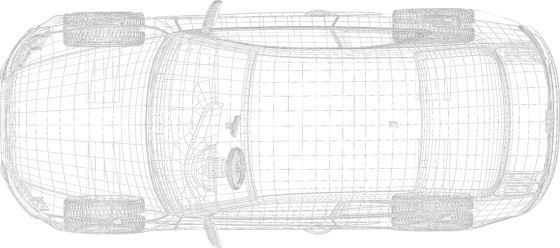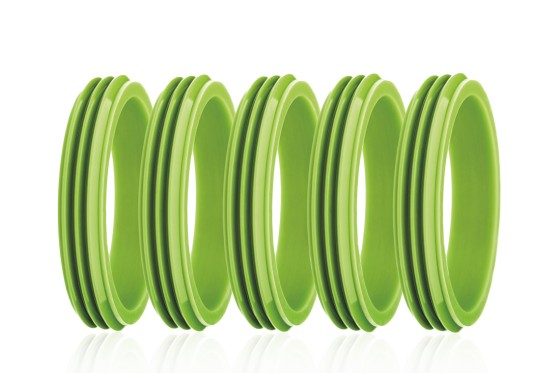Gaskets for Tomorrow’s Engines
The trend toward small cylinder capacities and compact designs means less space and more heat under the hood. As the coolant temperature increases, so does the load on the gaskets installed in the cooling circuit. A new liquid silicone rubber from WACKER masters these growing demands.



Motorbikes, small aircraft and gasoline-powered lawnmowers often still have air-cooled combustion engines to this day. Even legendary car models such as the VW Beetle or the Citroën 2CV, which were produced in large quantities until the 1970s, still had air-cooled engines under the hood. Sports-car drivers, in particular, appreciated this drive, not least because of its powerful sound. That’s why some Porsche enthusiasts were sorry when the Swabian sports-car maker – as the last of Germany’s car manufacturers – said farewell to air cooling in 1998 with its new 911 model.
Nowadays, the combustion engines of almost all car models are liquid-cooled. The coolant – a mixture of water and glycol – circulates in a closed loop, and is cooled in the radiator. Modern combustion engines reach an efficiency of around 30 to 45 percent. Roughly estimated, some three-fifths of the heat created at temperatures of up to 2,500 °C remains unused – it’s waste heat. Around half of the waste heat is discharged through the tailpipe with the exhaust gases; the remainder raises the temperature of the engine, especially the cylinder block, the cylinder head and the pistons. To prevent the engine from overheating, the cylinder block and cylinder head are cooled with coolant.
During operation, the cooling circuit has a gauge pressure of up to 1.5 bar. This increases the coolant’s boiling point. At a gauge pressure of 1.5 bar, the water-glycol-based coolant only boils once it reaches around 125 °C and not at 110 °C, its boiling point under atmospheric pressure. This creates a larger temperature gradient in the radiator, which can be used to transfer heat from the hot coolant to the ambient air. The operating state of the engine dictates the coolant temperature; if no exceptionally high engine output is required, it averages at approximately 90 °C.
Fan for Reinforcement

Car radiator: here, temperatures are 90 °C and above. Gaskets (yellow) must withstand such conditions and remain functional for many years.
The coolant pump is responsible for transporting the coolant. It delivers the cooled-off coolant from the radiator to the hot engine components. From there, the heated-up coolant goes back to the radiator. A sensor near the cylinder-head outlet measures the coolant temperature. This is the operating temperature observed by the driver. If it exceeds a certain value, the fan in front of the radiator switches on and reinforces the cooling effect.
The engine cooling system prevents the engine parts, especially the cylinder wear parts, from warping, ensures that the friction-reducing oil film is maintained by preventing the motor oil from carbonizing and helps sustain a controlled combustion process. Insufficient cooling, caused for example by a loss of coolant, quickly leads to much-feared piston scoring and other major engine damage. Therefore, it is extremely important that the gaskets used in the cooling circuit function properly.
Parts in the radiator, coolant pump, thermostat and coolant reservoir are connected up, but detachable. To ensure that no coolant is lost, the connections must be leak-tight – under operating conditions, no liquid must escape from the joined components during their entire service life.
Sensor on the Cylinder Head
The Product
ELASTOSIL® LR 3022/60 is a coolant-resistant liquid silicone for the automotive industry. Elastomers have good resilience and sealing effect, even for long periods of time.
Prefabricated elastomer molded gaskets are used at many points in the system to ensure it is leak-tight. Most are molded parts that are installed in a groove created for this purpose in the mating surface of one of the two components. They are then compressed when the second component is installed.
This compression uses the rubber-elastic properties of the elastomer – because of its resilience, the elastomer is not permanently, but reversibly, deformed. During compression, a mechanical stress is created in the molded elastomer seal, which presses the sealant material onto the surrounding surfaces of the components. If the seal was compressed enough, it seals off the connection.
The resilience of a molded elastomer seal under the existing conditions should change as little as possible so that it remains leak-tight over a long period of time. Considering the heavy loads that the gaskets in the cooling circuit are under, this is a serious challenge for material engineers. The compression that the gaskets are subject to during installation imposes a sustained static deformation on the elastomer. And when the engine is running, there are additional dynamic loads (loads that change with time) such as oscillations and torsions. However, most of all, the elastomer must withstand the effects of the coolant. This loading is especially severe when the liquid is hot.
Engine cooling is made more difficult by the downsizing trend of engines. Engineers are reducing the cylinder capacity and the number of cylinders. The missing torque is compensated by direct injection and higher pressures via turbocharging. However, this results in greater heat flux in the engine. At the same time, space under the hood is becoming increasingly cramped – the trend toward compact design is adding to the difficulty of dissipating the heat. As a result of all these measures, the average temperature in the engine compartment is increasing.
Rising Temperatures
There are very few elastic sealant materials that can handle this increased thermal loading. For example, conventional silicone elastomers are chemically attacked by glycol – one of the coolant’s two main components – at temperatures over 100 °C. Therefore, they cannot generally be used for sealing purposes that involve direct contact with hot coolant. So far, molded seals made of organic elastomers have mainly been used. However, in light of the trend toward higher temperatures in the engine compartment, the automotive industry is beginning to greatly increase its demands on gasket materials.
New Silicone Formula

Gaskets made of ELASTOSIL® LR 3022. The new liquid silicone has been specially developed for the automotive industry.
In ELASTOSIL® LR 3022/60, WACKER has developed a new liquid rubber for the manufacture of molded seals. Gaskets made of this silicone maintain their sealing effect, even in prolonged contact with hot coolant at temperatures of 125 °C. “The new silicone rubber was specially formulated so that the gaskets can withstand the difficult conditions in the cooling circuit over their entire lifetime,” emphasizes Dr. Thomas Frese, head of an applications laboratory at WACKER in Burghausen, who significantly contributed to the development of the novel silicone elastomer. “A gasket made of this material maintains sufficiently high resilience in direct contact with hot coolant over the long term.”
Thus, the product’s compression set – the technical parameter determined on a test specimen that describes the elastomer’s resilience – is no greater than 50 percent, even after a thousand hours under long-term aging in a pressurized coolant at 125 °C. This means that a test specimen that’s compressed to three-quarters of its thickness and placed in boiling coolant for around 42 days regains at least half its compacted amount after decompression. So, after stress relief, 50 percent of the deformation remains at most. More specifically, this means that a 1.2-millimeter gasket compressed to 0.9 millimeter and stored in boiling coolant would regain around half of its original form’s compacted amount when unbolted. Thus, the gasket now measures at least 1.05 millimeters.
“This is a very good value, previously unattained by liquid rubber grades under such harsh testing conditions,” stresses WACKER chemist Frese. Thus, the tests show that a molded seal made of this new material maintains its sealing effect even after a long time in hot coolant.
“ELASTOSIL® LR 3022/60 provides the automotive industry with a high-quality alternative to organic rubber grades.”
Wolfgang Schattenmann, Head of the Rubber Solutions Business TeamSilicones Like It Hot and Cold

Furthermore, the cured rubber features typical silicone properties. These include its excellent heat resistance and low-temperature flexibility down to -45 °C. Even at very low temperatures, which could occur in a cooled-down engine during hard northern winter nights, the cured rubber made with ELASTOSIL® LR 3022/60 remains elastic. These properties make the new silicone ideal for use in cooling circuits. In addition, as a liquid silicone rubber, ELASTOSIL® LR 3022/60 can be injection molded with ease, enabling cost-effective mass production of various gaskets and other molded parts intended for applications involving direct contact with coolant.
“This provides the automotive industry with a high-quality alternative to organic rubber grades,” explains Dr. Wolfgang Schattenmann, head of the Rubber Solutions business team at WACKER SILICONES. According to Schattenmann, this new specialty silicone can handle even greater loads than presently occur in the engine cooling circuit. “Thanks to ELASTOSIL® LR 3022/60, automobile-industry suppliers should have no worries about stricter test specifications that are expected to be introduced by car manufacturers for molded gaskets that come into contact with coolant.”
